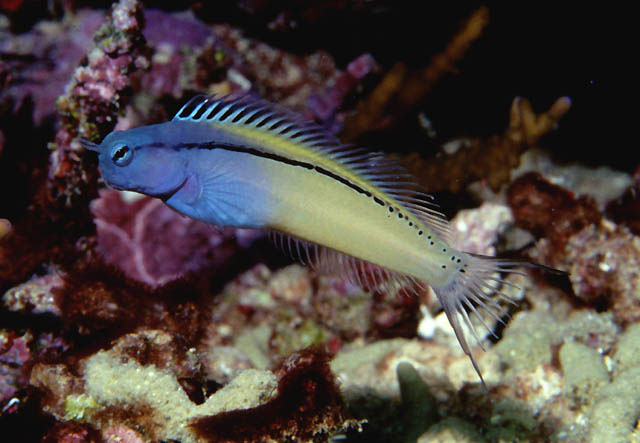| Blenniidae (Combtooth blennies), subfamily: Salariinae |
| 8 cm TL (male/unsexed) |
|
reef-associated; marine |
| Western Indian Ocean: Red Sea (including the Gulf of Aqaba) to the westernmost Gulf of Aden. |
|
Dorsal spines (total): 12-14; Dorsal soft rays (total): 16-19; Anal spines: 2-2; Anal soft rays: 18-21; Vertebrae: 35-37. Dorsal fin typically XIII, 16-19 (rarely 16 or 19), spinous and segmented-ray portions with moderate notch in-between. Anal fin II,18-21 (rarely 18 or 21). Pectoral fin 13-15 (rarely 13, typically 14). Segmented caudal-fin rays 13. Vertebrae 10 or 11 (rarely 10) + 24-26 (rarely
24) = 35-37 (rarely 35). Dentary incisor teeth which includes anterior canine teeth very similar in appearance with incisors, 44-54; posterior dentary canines 0 or 1 (typically 1) on each side. Lateral line lacking pairs of pores, terminating posteriorly at a point between verticals from dorsal-fin spines 8 and 11 (rarely as far anteriorly as 8). With cirrus on posterior rim of anterior nostril; absent on anterior rim. Two color patterns: pale (northern) and dark (southern). |
| Mimics Meiacanthus nigrolineatus (Ref. 9710). Oviparous. Eggs are demersal and adhesive (Ref. 205), and are attached to the substrate via a filamentous, adhesive pad or pedestal (Ref. 94114). Larvae are planktonic, often found in shallow, coastal waters (Ref. 94114). |
|
Least Concern (LC); Date assessed: 25 March 2009 Ref. (130435)
|
| harmless |
|
Source and more info: www.fishbase.org. For personal, classroom, and other internal use only. Not for publication.

